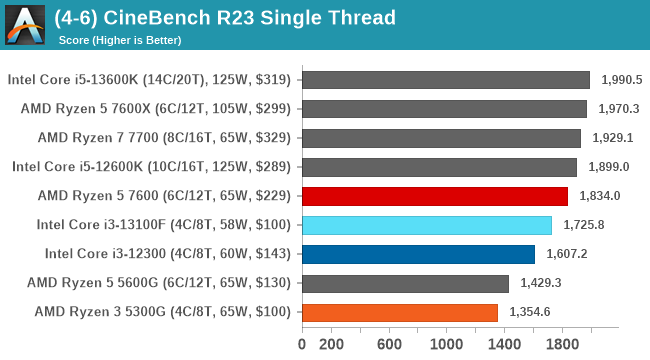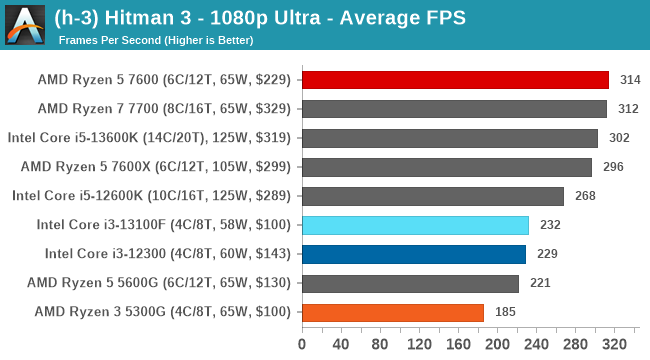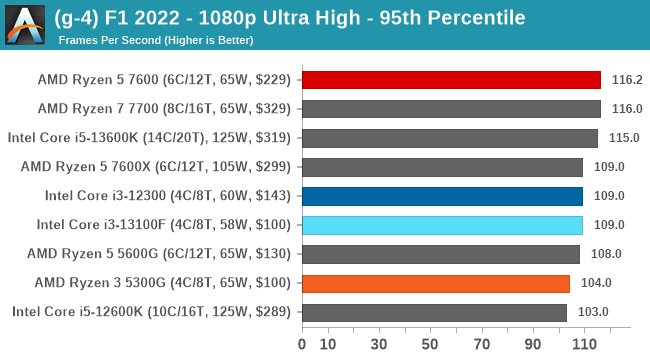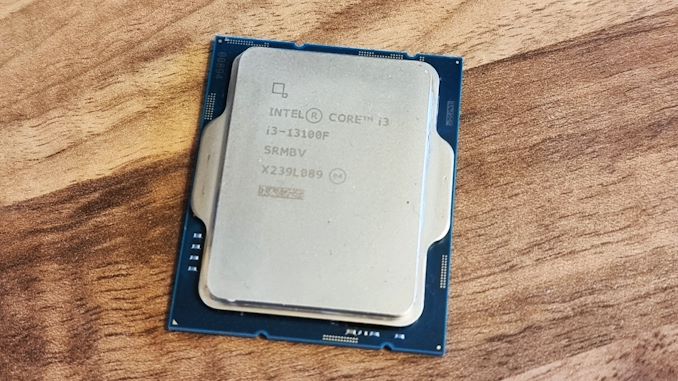The Intel Core i3-13100F Review: Finding Value in Intel's Cheapest Core Chip
by Gavin Bonshor on April 20, 2023 9:00 AM ESTConclusion
It feels like it's been ages since a quad-core CPU was considered an essential SKU in Intel's arsenal. Throughout many generations of Intel's architectures, including the fabled Sandy Bridge, Haswell, and Skylake, to name a few, it wasn't until the launch of its Coffee Lake family of parts (8th Gen Core) that we saw Intel going beyond four cores for its desktop platform. Since then, Intel hasn't looked back. They have iteratively increased their core/thread counts with the optimization and efficiency of their manufacturing processes, leading to processors with core counts that would have seemed absurd at the start of the Sandy Bridge era.
But, in 2023, is there value to be had in a desktop CPU that offers just four CPU cores? Right now, a four core CPU is certainly at the extreme end of matters for an Intel desktop platform, with the same 13th Gen Core series offering up to 24 cores on its top SKUs. The same can be said for AMD's top-tier offerings, such as the Ryzen 9 7950X, the gaming-centric Ryzen 9 7950X3D, and Ryzen 9 7900X3D, as well as the most recent Ryzen 7 7800X3D. The issue, of course, is that not everyone can afford such an expensive CPU as the ones mentioned above, which typically cost upwards of $600. That's where options such as the quad-core Intel Core i3-13100F come into play with a far friendlier price tag of $100.
Even in the sub $150 space, AMD has the previous generation Ryzen 5 5600G 6-core APU, which is currently $138 at Amazon, and the entry-level quad-core Ryzen 3 5300G. Although the Ryzen 3 5300G was OEM only at its launch, these days it's publicly available for around $100, making it AMD's most recent quad-core offering on the market. With the Core i3-13100F also running for $100 at Amazon currently, the budget space certainly has plenty of options to select from, but it's time to see how the latest quad-core from Intel stacks up against the rest.
Intel Core i3-13100F Performance Analysis
Let's make no mistake about it; the Core i3 series isn't designed for heavy and intensive workloads, multi-threaded performance, or tasks such as video rendering and encoding, but for an MSRP of $109 and a current selling price of $100 at Amazon, quad-core desktop systems aren't dead, at least not yet. As we've done recently in our CPU reviews, we're splitting our analysis into two sections, compute performance and gaming performance.
Intel Core i3-13100F: Compute Performance, Four Cores has Limitations
Looking at how Intel's latest quad-core offerings compete in the sub $350 processor market, as expected, compute performance is limited considerably in workloads that are optimized for higher core counts. Judging the Core i3-13100F on its merits without comparing performance to the more extensive and much more expensive AMD Ryzen 9 7950X 16C/32T and Intel Core i9-13900K 24C/32T flagships, the Core i3-13100F does very well all things considered.

In our Persistence of Vision Raytracer (POV-Ray) benchmark, we can see that in an optimized multi-threaded workload, the four cores of the Core i3-13100F make it faster than every other quad core chip in our charts – handily surpassing AMD's quad 5300G by around 28% at the same price – but still noticeably behind more expensive chips with more cores. MT-loving workloads are, essentially, what these cheap chips are giving up on in order to keep their costs down and fill out their respective CPU product stacks.

Using the CineBench R23 Single-Threaded test to show the single-threaded performance of the chips tested in this review, we can see that the Core i3-13100F offers an improved result of around 7% compared to the Core i3-12300 for a small 2% bump in turbo core frequency (4400 versus 4500 MHz). That's a respectable gain in single-threaded performance, and multi-threaded performance has been improved by around 4-8% throughout most of our compute testing compared to the Core i3-12300. Comparing it to the Ryzen 3 5300G, the Core i3-13100F is ahead by around 21% in CB23 ST. Meanwhile, in a sign that things aren't quite as stratified overall for the CPU market when it comes to single/lightly-threaded workloads, the i3-13100F is only 5% behind the $229 Ryzen 5 7600, AMD's most budget-friendly Zen 4 architecture chip.
It's a similar story across the majority of our compute-focused test suite, with the Core i3-13100F typically edging the previous generation Core i3-12300 out marginally and coming in with lower levels of performance against AMD's cheapest Ryzen 7000 series processor, the Ryzen 7 7600 which does have six Zen 4 cores under its hood. In multi-threaded tasks, the $138 Ryzen 5 5600G (6C/12T) APU performs remarkably well for its price tag, despite being from the previous generation Zen 3 line-up. As an added bonus, this chip is an APU, it has superior integrated graphics, which for titles outside of recent AAA, is still solid for 60 FPS gaming at low resolutions with lower levels of settings.
Intel Core i3-13100F Gaming Performance: Decent Performance, but Again, has Limitations
Moving onto gaming performance, we can see that gaming with the Core i3-13100F at 720p and 1080p has certain limitations by having just four cores. Despite having superior IPC performance compared to Intel's previous generations, many games now are multi-platform console ports, which is to say that they've been designed around a larger number of CPU cores (and may be questionably optimized for the PC at all).

Despite having a measly four Golden Cove performance (P) cores under the hood, the Core i3-13100F still performs considerably well when paired with an AMD Radeon RX 6950 XT graphics card. Results may vary when paired with lower-end discrete graphics, though as these are all CPU-limited scenarios, most of these trends will hold Still, comparing things on a level basis, e.g., with memory at the highest-rated JEDEC specifications (DDR5-4800 over DDR4-3200) and the same hardware, the Core i3-13100F shows itself as more than good enough to spit out an acceptable number of frames in the games we've included in our benchmark suite.

We saw highly competitive performance between the Core i3-13100F and Core i3-12300, which is to be expected given they are essentially the same processor; one is just badged as 13th Gen and has 100 MHz more on the turbo core clock speeds.
Ultimately, we're not expecting that users going for a gaming system based around a i3-13100 or i3-13100F are aiming for a high-end experience. But quad core chips can't be written off wholesale for budget gaming systems – at least not yet. As multi-platform games shift from the previous gen consoles being the baseline to the current generation, Zen-2 based fare, that will understandably change. But right now there's still a lot a quad core CPU can handle, especially if you're being equally thrifty on the software side of matters and working through your Steam backlog (ed: guilty).
Intel is offering its chips on a cheaper core-to-price ratio, and delivering respectable performance levels at entry-level and mid-range price points. Diving a little deeper into the pricing, the Core i3-13100F costs roughly $25 per core, which drops to $22 per core on the Core i5-13600K. Which makes the latter technically a bit cheaper per core, but it should also be noted that only six of these are P cores, while the remaining eight are lower-performing E cores.
Meanwhile, the Ryzen 5 5600G ($138) costs $23 per core, and the Ryzen 3 5300G ($100) costs $25 per core. Although this isn't a metric that should be entirely relied upon just for performance purposes, it's certainly interesting.
Final Thoughts: Core i3-13100F is Solid at $100 – Just Bring Your Own Video Card
In 2023, technology will continue to evolve, and the demand for processing power will increase. Many entry-level laptops and desktops still have quad-core processors and are perfectly adequate for everyday use. This doesn't always hold for more CPU-intensive tasks, of course, but that's the nature of making a trade-off with a cheaper CPU.
As things stand, while more advanced software such as video editing or 3D rendering may require more processing power, four cores can still perform reasonably for many users. This is especially true if the software is not heavily multi-threaded, meaning it cannot take full advantage of multiple cores simultaneously. In such cases, a quad-core processor such as the Core i3-13100F may provide comparable performance to a higher-core-count processor that is not fully utilized. This is more prevalent in single-threaded applications, but Intel has opted for its Golden Cove performance cores instead of its newer Raptor Cove cores as its go-to cores. This makes the 13th Gen Core i3 series more of a refresh with a clock speed bump than a new product.
Still, it is worth noting that technological advancements have allowed processors to become more efficient and effective in utilizing their available cores. This means that even with just four cores, modern processors can still handle more demanding tasks than before through gains to IPC performance and increases in core clock speeds while remaining at a similar power curve to the previous generation.
If Intel had used its newer Raptor Cove performance (P) cores as it does with its other 13th Gen Core i7 and i9 series, Intel could probably have squeezed out some more performance. Still, it's understandable as it would have inflated the Core i3 pricing up, and with only four cores, it would still be limited in multi-threaded scenarios.
Which brings us to Intel's Core i3-13100F. Intel's cheapest quad core processor in the 13th Gen Core processor stack is an improvement over the 12th Gen Core i3 offerings, though it's rather marginal. The biggest improvement, really, isn't on performance, but rather on price (and thus cost effectiveness). Especially with current retail pricing of just $100, the i3-13100F is a much better deal than the 12th Gen i3 chips it replaces. It's clear that Intel has been meticulous about fine-tuning their product stack, and while the i3-13100F doesn't bring anything new to the table in terms of technology or performance, it does a good job of filling the need for a cheap quad core chip within Intel's lineup.
Not that Intel is being solely insular, here. In the budget market AMD's previous Ryzen 5 5600G ($138) and Ryzen 3 5300G ($100) chips put up a fight, which does shake things up from a performance and pricing perspective. From a pure CPU performance perspective Intel has the better quad core chip, but AMD does have an edge in offering integrated graphics at the same price. It's not an unfamiliar trade-off in this space; system builders who need integrated graphics as well can either turn to AMD's chip or step up to Intel's full i3-13100 ($110), otherwise if you're going the BYOG route, the i3-13100F is in a better position to let everything ride on CPU performance.
For what it's worth, Intel does end up with a slight edge on some platform aspect as well – support for both DDR5 and DDR4 memory come to mind – though even with the recent drops in DDR5 memory prices, it's hard to make an argument for the more expensive memory with such a cheap chip. Still, the use of the common LGA 1700 platform means that i3-13100F systems also leave the door open to upgrading to a more powerful current-generation Raptor Lake processor later on, as rare as that will be.
In summary, while the demand for processing power increases in 2023, the Core i3-13100F can still be a viable and practical option for many users, especially at the entry-level, where basic photo manipulation, word processing, and web browsing are all going on – so long as you bring your own video card.
As stated throughout the review, the Intel Core i3-13100F is currently available for $100 at Amazon. In our opinion, it represents good value for money for entry-level users or when building a system where heavy workloads aren't a key factor. When combined with a motherboard such as the ASRock B660M-HDV ($95) and a 16 GB kit of TeamGroup T-Force Vulcan Z DDR4-3200 memory ($40) for a total of $255, users can use the rest of whatever budget is left on a graphics card which will predominantly set what the system is capable of in gaming.











34 Comments
View All Comments
nandnandnand - Friday, April 21, 2023 - link
Now that AMD is offering an iGPU on all current AM5 CPUs, it will be interesting to see if Intel changes its 'F' strategy in any way, which has been the norm for several generations in a row. Intel already cuts down EU count from 32 to 24/16 (UHD 730/710). Might as well go to 16 (50%) instead of zero graphics.It would also be nice to see Intel compete with AMD APUs. Put 96-128 EUs on a desktop chip.
mode_13h - Friday, April 21, 2023 - link
Thanks for the review, guys. Unfortunately, it didn't answer a key question I had: WHAT IS THIS CHIP?Was it made on Intel 7 or Raptor Lake's improved version? Does it have any silicon-level improvements or tweaks? Is it exactly the same die as the small Alder Lake desktop CPUs, but with the GPU disabled and maybe some microcode tweaks?
nandnandnand - Saturday, April 22, 2023 - link
I don't know if it was ever officially confirmed anywhere, but it should be identical to the i3-12100F, based on the same 6+0 die used to make the 12400/12500/12600 (non-K) on the same version of Intel 7. Just with 100 MHz higher base and 200 MHz higher boost clocks.Intel will get another chance to do something interesting at the low-end with Raptor Lake Refresh later this year. For example, a 4+4 based on a different die.
https://videocardz.com/newz/upcoming-intel-raptor-...
Otritus - Saturday, April 22, 2023 - link
All 13th generation CPUs below the 13600K are made using Alder Lake dies. The i5s are made with Alder Lake's 8+8 design. The i3s are most likely made with Alder Lake's 6+0 design, as cutting from 8+8 down to 4+0 is probably less profitable compared to using 6+0. There is a Raptor Lake 6+0 die I believe, but Intel did not release it due to having a glut of Alder Lake dies.ads295 - Saturday, April 22, 2023 - link
1. What's the most powerful GPU you could pair with this and some fast RAM?2. What games could that run?
Trying to understand how this fits into a budget gaming build.
Otritus - Saturday, April 22, 2023 - link
The interesting thing about bottlenecks is that there is almost never a pure bottleneck towards any single component. This means you could arguably pair this processor with a 7900XTX to get maximum raster performance. The problem with this processor having 4 cores is that it is going to be a bottleneck in any modern game that isn't some simple indie game. The processor is however fast enough to hit 60 FPS in all older games and most if not all newer ones. AMD drivers have less CPU overhead than Nvidia ones, so AMD will be faster on this processor. You can easily get away with DDR4-3200 on this processor, and it can run all games. I probably wouldn't pair this CPU with anything faster than a 3070, but a 3060 or 6600XT seem pretty reasonable.valtteris_big_batteries - Saturday, April 22, 2023 - link
Great review, something I've been thinking about for a long time. Does seem like going with an AM4 5600G achieves better points overall, but for situations like mine where I have a lot of spare legacy dGPUs from a longtime tech addiction, the 13100F makes a case in price.kkilobyte - Sunday, April 23, 2023 - link
I really wonder what the point is to compare such low-end CPUs coupled with a high-end GPU?On amazon where I live (Belgium), the lowest price for the RX 6950XT is about 750€, and most references available are priced above 800€.
So how is it a "good value for money for entry-level users" ? It doesn't have an iGPU, so you must factor that in the total cost. For reference, a GT710 (which is really scrapping the bottom of the barrel) is priced at around 50€ on amazon. The 13100F is listed there at 125€, while the Ryzen 5600G is at 132€. So, if you factor the GPU price in, that becomes a 132 vs 175€ comparaison, adding that the Ryzen iGPU is better than a GT710. Even if you add the motherboard in the equation, the Ryzen will still cost less: there are several B550 motherboards listed at around 110€. So that would put the price of the AMD-based platform at 242€ vs 270€, and you'd get a more capable platform for most tasks, including gaming.
So, what exactly is the point of that test, if not showing that picking the -F serie is not economically sound? I don't understand your conclusions at all, and think it is edging a bit on the dishonest side of things.
abufrejoval - Monday, April 24, 2023 - link
It's *your* fault, that I keep buying these new computers.But I couldn't do it if it wasn't for the kids and in-laws that I could push the older devices to.
And in both camps there are still Ivy Bridge i7-3770 (not even K), which for some reason run quite happily at up to 4.2GHz using 16GB of DDR3. There are also some Kaby Lake i7-7700K (@4.8GHz), generally with DDR3-2400, because DDR4 was what DDR5 is now.
In terms of GPU it's GTX980ti, GTX1070 typically and they are completely happy!
Mostly because they have 1920x1080 screens.
When I chance to look at them playing, I actually often feel a bit jealous, because my RTX3090 with the Ryzen 5950X somehow doesn't seem to get close.... at 4k.
Of course, most of it is simply that they really know how to game, while I'm just a 10 minute dabbler (well, actually it's 10 seconds until I'm dead and 10 minutes until I give up trying).
This discussion reminds me about the i3-7350K, a dual core Kaby Lake with hyper threading, which was hotly debated here vs. a "true quad" like the i5-7600K. I got one of those at the time and tried it and it was really rather capable; the main reason I eventually replaced it with a true quad was that those became rather cheap and I wanted to retain the value of the rest of the system, basically until today.
Since I'm not a competent gamer, I might simply not be sensitive enough to notice the slight slow-downs that might be caused by "temporary core shortages" these days. But when I look at CPU graphs on my really big machines (16-18 cores), I don't see even recent games using lots of cores.
Some, like the even the most recent version of Microsoft's Flight Simulator remain essentially single-threaded, others might use a little more but since truly balancing a gaming workload across 4, 8, 16 or more cores is very difficult to do, it's still rarely getting done.
So if you are tight on the money, I'd also argue that the extra €50-100 are better spent on GPU, DRAM or SSD. At the same time extra cores will sleep saving thermal and electrical budget and give you the peace of mind that if you need the extra oomp, you can have it.
I'd second the request to provide a bit of an overview on the current chips that Intel produces to navigate the near infinite number of SKUs they produce from them.
And it seems that this really is a cut down version of what might already be the smallest (non-mobile) AD die, because for a Raptor Lake die, such a chip sounds like 30% active surface area, hard to imagine as a real yield result.
I realize that Intel itself isn't keen on having that information out in the public, but that's why we turn to Anandtech: to learn more than vendors preach already.
Otritus - Monday, April 24, 2023 - link
Modern games only need 6 cores to run properly. Consoles just got 8 proper high performance cores with SMT in 2020. In the future you will probably need 8 SMT cores or 6-7 SMT cores with little cores for background tasks. It's why Intel only maxes out with 8 P-cores before adding in little cores, and why the i5 still has 6 P-cores.The die used was Alder Lake's 6+0 die cut down into a 4+0 configuration. Raptor Lake also has its own die of 6+0 I believe that Intel never used due to a glut of Alder Lake dies.